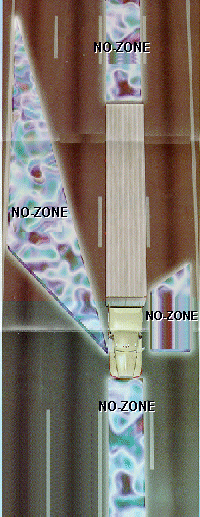The Key to Safer Highways:
Know the No-ZoneThe No-Zone represents danger areas around trunks
where crashes are more likely to occur.
Passing
When motorcycles cut in too soon after passing, then abruptly slow down, truck drivers are
forced to compensate with little time or room to spare. Because it takes longer to pass a
large vehicle, you should maintain a consistent speed when passing and be sure you can see
the cab of the truck in your rear-view mirror before pulling in front.
Backing Up
When a truck is backing up, it sometimes must temporarily block the street to maneuver its
trailer accurately. Never pass close behind a truck that is preparing to back up or is in
the process of backing up. Remember, most trailers are 8 1/2 feet wide and can completely
hide objects that suddenly come between them and a loading area. So if you try to pass
behind the truck, you enter a (No-Zone)
blindspot for you and the truck driver. |
|
 |
|
Rear Blindspots
Unlike cars, trucks have deep blindspots directly behind them. Avoid
tailgating in this No-Zone. the truck driver
can't see your motorcycle in this position and your own view of traffic flow is severely
reduced. Following too closely greatly increases your chance of a rear-end collision with
a truck.Side Blindspots
Trucks have much larger blindspots on both sides of their vehicles than
passenger vehicles or motorcycles. when you drive in these blindspots (No-Zones) for any length of time, you can't be
seen by truck drivers. If a commercial driver needs to change lanes quickly for any
reason, a serious crash could occur with the vehicle in the No-Zone.
Wide Turns
Truck drivers sometimes need to swing wide to the left in order to safely negotiate a
right turn. They cannot see cars directly behind or beside them. Cutting in between the
commercial vehicle and the curb or shorter to the right increases the possibility of a
crash. |

